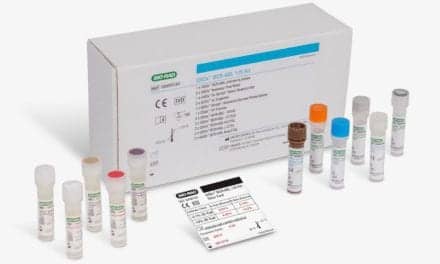FDA has recently granted de novo market clearance to Oxford Gene Technology, Oxford, UK, for eight Cytocell Aquarius hematology fluorescence in situ hybridization (FISH) probes for acute myeloid leukemia (AML) and myelodysplastic syndromes (MDS).
The Cytocell Aquarius AML/MDS range of FISH probe test kits are used to detect common chromosomal rearrangements in fixed bone marrow specimens from patients with AML or MDS. The tests are indicated for the characterization of patient specimens consistent with World Health Organization guidelines and in conjunction with other clinicopathological criteria.1 The assay results are to be interpreted by a qualified pathologist or cytogeneticist and are not intended for use as a standalone diagnostic, disease screening, or as a companion diagnostic.
The probes form the largest FDA-cleared in vitro diagnostic (IVD) FISH probe range for AML and MDS on the market and will address a substantial proportion of diagnostic laboratory hematological FISH testing. The cleared probes will significantly reduce the level of validation required in laboratories and provide accurate, easy-to-interpret detection of chromosomal rearrangements reported in AML and MDS. The full list of FDA-cleared Cytocell Aquarius FISH probes includes:
- AML1/ETO (RUNX1/RUNX1T1) translocation, dual fusion
- CBF? (CBFB)/MYH11 translocation, dual fusion
- Del(5q) deletion
- Del(7q) deletion
- Del(20q) deletion
- EVI1 (MECOM) breakapart
- MLL (KMT2A) breakapart
- P53 (TP53) deletion
The probes are supplied premixed and ready-to-use as part of a complete kit, including 4?,6-diamidino-2-phenylindole (DAPI), and detailed protocols and signal pattern analysis guidelines, which streamline processing and minimize errors. Bright, tight, and high-intensity signals with excellent contrast simplify analyses, while decreasing retest rates. Cytocell FISH probe users also have access to OGT’s technical support.
“We’re delighted to bring our comprehensive range of FDA-cleared AML and MDS FISH probes to market,” says Steve Chatters, director of medical affairs at Oxford Gene Technology. “The rigorous FDA de novo pathway requires submission of extensive clinical and performance data from multiple sites, along with robust evidence of the safety and effectiveness of the probes.
“What this means for customers, particularly in the US, is a significant reduction in the validation burden and immediate access to a range of high-quality IVD probes covering a comprehensive set of rearrangements,” adds Chatters. “Our customers will be able to easily and accurately detect pertinent chromosomal rearrangements in fixed bone marrow specimens without needing to complete lengthy validations for every probe prior to use.”
“Gaining FDA clearance for this range of probes is a real milestone for OGT and our customers, demonstrating our continued commitment to developing and providing molecular diagnostic solutions as part of Sysmex,” says John Anson, PhD, CEO of OGT. “We see FISH technology very much as a long-term diagnostic solution and we are committed to continuing to expand the Cytocell portfolio with new diagnostic products. This is a significant step towards achieving that goal, immediately benefiting our customers by providing access to the largest range of FDA-cleared FISH probes for AML and MDS currently on the market.”
For more information, visit Oxford Gene Technology.
Reference
- Swerdlow SH, Campo E, Harris NL, Jaffe ES, Pileri SA, Stein H, Thiele J, eds. Classification of Tumors of Hematopoietic and Lymphoid Tissues. 4th ed. WHO Classification of Tumors, vol. 2. Geneva: World Health Organization, 2014.
Featured image: The EVI1 (MECOM) breakapart FISH probe kit is a fluorescence in situ hybridization test used to detect rearrangements involving the EVI1 (MECOM) region on chromosome 3 at location 3q26.2, in fixed bone marrow specimens from patients with acute myeloid leukemia or myelodysplastic syndrome. Photo courtesy Oxford Gene Technology.







